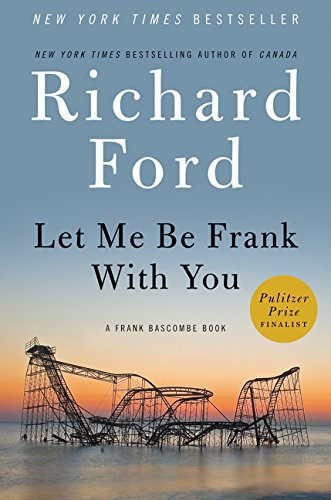It takes close to 1,300 pages of Richard Ford’s critically acclaimed Frank Bascombe novels to reach the stories’ philosophical rub. Halfway through Let Me Be Frank With You, the latest and fourth installment in the series, Frank is visiting his ex-wife Ann in hospital. “Being an essentialist, Ann believes we all have selves,” he thinks, mulling over why he still fails to connect with her. “Character to me, is one more lie of history and the dramatic arts. In my view, we have only what we did yesterday, what we do today, and what we might still do.”


 For fans of these painstakingly crafted books – beginning with The Sportswriter (1986), and moving through its sequels Independence Day (1995), and The Lay of the Land (2006) – the revelation that Frank is existentially adrift might not be news, but it’s rare to see both Ford’s literary approach and Frank’s disconnection laid out with such brevity. Since we first met him 28 years ago – “My name is Frank Bascombe. I am a sportswriter,” reads the tetralogy’s opening line – Frank has defined himself by roles he’s played, whether it’s jobs (journalist, realtor) or periods of his life (the Default Period, the Existence Period). However it’s always been implicit that there is an associated void, an attraction to “mystery” ahead of facts, a detachment exacerbated by the uncontrollable nature of life and partly explained by it. To see this relinquishment to contingency spelled out so clearly goes to the heart of why Let Me Be Frank With You succeeds. Such clarity also complements the novel’s unconventional structure – the book is molded as four separate stories instead of the complete written through novel we have seen previously.
For fans of these painstakingly crafted books – beginning with The Sportswriter (1986), and moving through its sequels Independence Day (1995), and The Lay of the Land (2006) – the revelation that Frank is existentially adrift might not be news, but it’s rare to see both Ford’s literary approach and Frank’s disconnection laid out with such brevity. Since we first met him 28 years ago – “My name is Frank Bascombe. I am a sportswriter,” reads the tetralogy’s opening line – Frank has defined himself by roles he’s played, whether it’s jobs (journalist, realtor) or periods of his life (the Default Period, the Existence Period). However it’s always been implicit that there is an associated void, an attraction to “mystery” ahead of facts, a detachment exacerbated by the uncontrollable nature of life and partly explained by it. To see this relinquishment to contingency spelled out so clearly goes to the heart of why Let Me Be Frank With You succeeds. Such clarity also complements the novel’s unconventional structure – the book is molded as four separate stories instead of the complete written through novel we have seen previously.
To recount the details of Frank’s life, as is usual in a review, seems somehow a betrayal of his character, since classifiers and summaries of his relationships and homes don’t quite define him the way his actions do. For the sake of context, though: Bascombe lives in New Jersey; he has variously been a short story writer, a failed novelist, a teacher, before turning to real estate; his first marriage to Ann hit the rocks when Frank indulged in serial affairs, prompted by the death of their young son, Ralph; he has two other children, the wayward Paul, who goes into the gift cards business, and the stentorian Clarissa, a vet. Frank survives prostrate cancer and is now, at the age of 68, back with his once estranged second wife, Sally.
These events, and Frank’s submission to them, have always loosely been built around set-pieces. The Sportswriter features a meal Frank has with the family of a young nurse he’s dating, Vicki, and an interview he conducts with Herb, a wheelchair-bound former footballer. Independence Day’s climax occurs after Frank spends a disastrous trip away with Paul during the titular holiday, and The Lay of the Land has him preparing for Thanksgiving. However all of them also see Frank adrift on a sea of characters, places and events that meander away from solid structural ground: Independence Day’s father-son bonding session kicks off over halfway through its 400 pages and The Lay of the Land’s ruminative digressions saw Michiko Kakutani criticize it for its “pages and pages of self-indulgent self-analysis.”
Now, in Let Me Be Frank, Ford writes just four loosely connected set-piece stories to get to the heart of what Frank is — four different events, all of them out of his control (hurricane, stranger appearing, wife’s illness, friend’s death) doing what he’s doing yesterday, today, and tomorrow, and dealing with them as best he can (there’s also a certain irony here, as Frank himself abandoned novels early in his career because he had, he says, “no talent” for the “longer form”). If there is anything essential to Frank’s character, it’s that he’s simply responding to what life throws his way. Ford heightens this by throwing in anecdotes not seen in the previous novels. There is also incredibly little about Frank’s childhood ever highlighted, something unthinkable, say, in Updike’s Rabbit books, where we feel like we have been living with Rabbit for several decades by the end of the saga. Frank, however, stays continually slippery, even if he becomes more comfortable in his discomfort.
The length of the book also gives Ford’s prose welcome precision. We still have the hallmark descriptive passages, mimetic dialogue and quotidian obsessions, but not so much in bulk. The beginning of the book’s first story, “I’m Here,” ventures into Updikean alliterative fury with its account of “fresh-cut lumber, clean white PVC, the lye-sniff of Sakrete, stinging sealants, sweet tar paper, and denatured spirits” but is mostly a detached take on the aftermath of a hurricane, a neat device for the sloughing off of previous identities. As he approaches death, Frank says he’s also “stripping back words,” which in his view “should no longer be usable”, as an aid to clearer thinking. He’s equally, he says, getting rid of old friends. “Since time invested determines the quality of a friendship, having more than five genuine friends is pretty much impossible.” Links to the past come through Proustian involuntary memory, when a Peter, Paul and Mary song heard over the phone leads to a musical potted history. “My mind fled back to the face of ultra-sensual Mary — cruel-mouthed, earthy, blond hair slashing…”
We have a persistence of the paradoxes that defined Ford’s earlier writing (“Sometimes things can seem worse just by not being better,” Frank tells Walter in The Sportswriter) as the character trudges into guilt-ridden fatalism. “I’m ready to cease and desist,” he says. “Yet somehow I feel implicated by everything’s dilapidation.” History comes to haunt him in the book’s second story, “Everything Could be Worse,” which recalls Joyce Carol Oates’s 1992 short story “Where Is Here?” when a former resident of Frank’s house in Haddam, who left in bloody circumstances, pays him a visit. This is the most formulaic narrative here, ending as it does with a momentary epiphany for Frank, and showcases the character’s obsession with phatic communication, the difference between what we say and what we really mean.
All the Frank novels have this: what he wishes he’d said instead, what he could have offered which would have achieved the same objective, the statements he considers to be lies. “It’s not that difficult to counsel the grieving,” he says. “I could’ve said, ‘Roosevelt was a far better choice than Willkie back in ‘40.’ Which would be as grief neutralizing as ‘What a friend we have in Jesus.’”
The remaining two stories zero in on Frank’s long-term adversary Ann, his first wife, who is now suffering from Parkinson’s. Most intriguingly, he has at last realized what led to the breakdown of his marriage, “what is unquenchable and absent in her,” several decades too late. Their combativeness has reached a nihilistic stalemate, where Frank dutifully visits his ex in her medically serviced apartment and the pair rehearse the same old arguments, though without the attendant wistfulness on Frank’s part that once gave frisson to their meeting. “Deaths of Others“ relives the suicide of Walter in The Sportswriter with the failing health of Eddie Medley, another former member of the beleaguered, ever depleting Divorced Men’s Club. It ends with a shoehorned denouement, not unwelcome if a reduced shadow of the more nuanced treatment of Walter’s death.
To finish, it is worth dwelling where we are with Frank with respect to Rabbit Angstrom, since the former’s rise came just as the latter dwindled, and the similarities — the obsession with property, the Emersonian rhetoric, the philanderer destroyed by the trauma of a child’s death, Haddam’s copper beech replacing Brewer’s cherry blossom — should not detract from the major differences.
Updike claimed to want to structure the Rabbit novels around a Joycean Odyssey, whereas Frank is tossed on life’s tide, the significant physical events that define him transpiring as if to someone else. Partly, this is because of his estrangement from Ann, and his children, but he also lacks a spiritual anchor, any lasting moment of transcendence that elevates him above the mire. Ironically it is Updike, a lifelong agnostic towards Emerson, who channels the latter’s “transparent eyeball” much more through his fiction (though it is Frank who is always quoting Emerson). Frank views the world as if he’s in a cinema, staring at the screen, preoccupied by something else. He’s also a greatly cleverer character than Rabbit and is a lifelong Democrat, a champion of the downtrodden, and is considerably less lucky. Ann never forgives Frank in the way Janice seems to with Rabbit, though the latter is far less contrite for his misdeeds.
Both men are Emersonian in their ability to reinvent themselves, “like a cat falls on his feet” as Emerson would say, and united in their absences and angst, a void Rabbit partway fills with Updike’s spirituality. With Frank, there’s no such luck. He’s cast adrift with only that which he can carry, without the lies of history and character to shoehorn him into unreality, and all the more truthful for it. Ford has only paid passing heed to his own rules in his Frank series, and in doing so pays tribute to his character’s protean nature. Where Ford attempts to contrive epiphanies, neat metaphors and acts of God, he does Frank a disservice.









